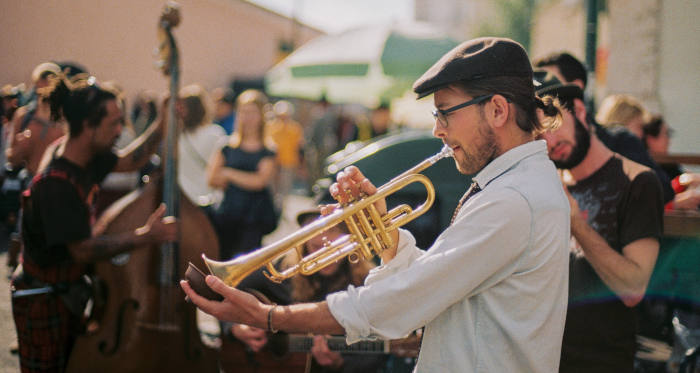
The embouchure is one of the most important aspects of playing any wind instrument. A correct embouchure will allow you to express yourself powerfully and play beautiful music. But a poor embouchure will frustrate your efforts to develop as a musician.
It took me three months to develop my own workable trumpet embouchure and around three years to perfect it. And I was able to play much more complex music once I had muscle strength and control.
Here we’ll look at what a proper embouchure looks and feels like and how you can train and develop your own.
What is a trumpet embouchure?
A trumpet embouchure is the placement of the lips, tongue and teeth when playing the trumpet. More specifically, it’s the right way to purse your lips together and use the muscles in your mouth to blow into the instrument. It also helps your lips vibrate in the mouthpiece to create the right sound from your trumpet.
Playing any wind instrument well requires a good embouchure. And although technique can differ between instruments, developing your embouchure for one will give you a head start on learning another.
Trumpets require a stronger embouchure than some other instruments. Whereas woodwinds have a vibrating reed that creates their sound, horns rely more on the airstream and lip movement.
How can a poor trumpet embouchure inhibit playing?
Embouchure strength is imperative if you want to reach even a basic proficiency with the trumpet. Reaching higher tones on the instrument requires greater strength. And you’ll be stuck playing in the middle range if your mouth can’t produce the force required to play in the upper register.
You’ll also find faster notes like 1/16th notes challenging because they require short bursts of strong air.
Steps for achieving a correct trumpet embouchure
Everyone’s embouchure can differ a bit, depending on their unique mouth shape and dental structure. But the basic concept is the same across different trumpeters.
Let’s look at the specific steps involved in achieving your embouchure:
1. Position your lips
Start by forming your lips together like you’re pronouncing the letter “M” or saying humming “mmm”. Keep your jaw relaxed, not clenched. Your top and bottom row of teeth should be apart a bit and not touching.
2. Draw the corners of your mouth outward
Flex your lips by pulling the corners of your mouth apart. You should feel some tension in the muscles of your cheeks. But you shouldn’t be curving your mouth upward into a smile. A curved vertical line formed on either side of your mouth usually shows your form is correct here.
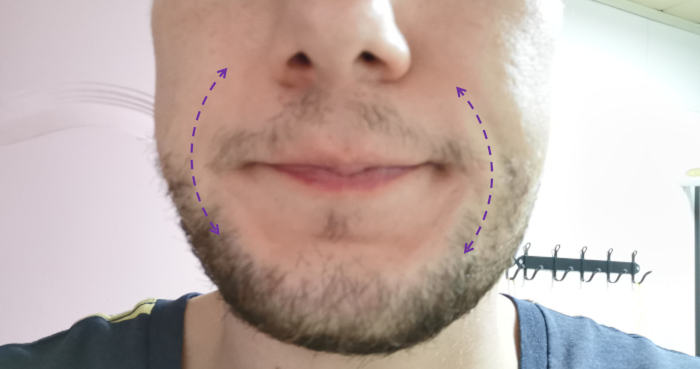
3. Blow through your lips
Blow air through your lips while maintaining the tension in your cheeks. Part your lips slightly, creating a gap known as the “aperture”. Make sure the front part of your chin remains flat and doesn’t bunch up or round outward.
This form is like how you’d shape your mouth when blowing into a hot beverage to cool it down. Checking in front of a mirror can help you ensure your form is correct.
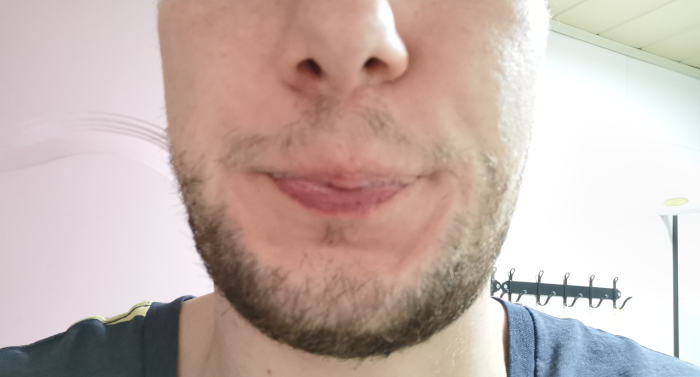
4. Narrow your aperture until you hear a “buzzing” sound
Slowly close the gap between your lips while blowing air out until your lips start to vibrate. You’ll feel some resistance from your pursed lips and might also feel a slight itching or tickling sensation there. Breathe from your diaphragm.
You should hear a “buzzing” sound once you’ve gotten this right.
5. Moisten your lips
Lick your lips a bit to get them slightly wet. They should be lubricated but not so much that the mouthpiece will slide uncontrollably over your mouth.
6. Place the trumpet mouthpiece on your lips
Detach the mouthpiece from your trumpet and bring it to your mouth, gently pressing it to your lips. The mouthpiece generally should sit directly in the middle of your lips—both vertically and horizontally.
The rim of the mouthpiece should rest above and below the red, fleshy part of your top and bottom lip. If you have bigger lips, roll or bend them a bit inward to expose more of the top and bottom part of your outer mouth to the mouthpiece.
Some musicians have some asymmetry to their mouth, such as a strong overbite. In such cases, the mouthpiece may sit more comfortably if you place it slightly off center. That’s OK. You just don’t want the mouthpiece resting directly over the red part of either lip.
7. Blow air into the mouthpiece and narrow your aperture
Start by blowing into the mouthpiece while keeping the proper mouth form. Then slowly narrow your aperture as before until you start getting that “buzz” sound from the mouthpiece.
The sound produced should be much closer to the true sound of the trumpet, even though you’re only blowing through the mouthpiece. Continue to practice in front of a mirror until the mouthpiece positioning and airflow action come naturally to you.
8. Attach the mouthpiece to the trumpet and blow into it
Return the mouthpiece to the trumpet and bring it to your lips. The trumpet should be resting at a bit of an angle with the bell pointed downward toward the floor.
Blow into the trumpet. Your technique should be the same as that in the last step. The main difference here is you’ll feel much more back-pressure resisting your airflow. That’s why you’ll want to confident blowing into the mouthpiece separately and breathing from your diaphragm first before you blow into the trumpet.
Your lips should vibrate inside the mouthpiece with that characteristic “buzz” right away.
Exercises for training your embouchure
Practicing the above steps is often enough for students to train their trumpet embouchure. But there are also other exercises you can work with to improve your endurance and condition the relevant muscles in your face for longer playing sessions:
Holding a pencil
Take an pencil and put it lengthwise against your closed teeth. Hold it in place using only your lips. Hold the pencil for as long as you can until your muscles fatigue.
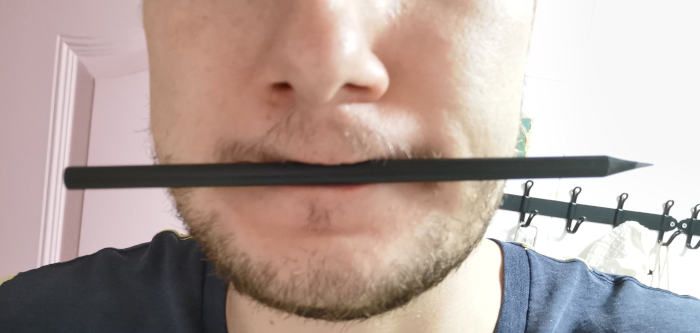
Smiling and puckering
Alternate between a wide smile and puckered lips with pressure. Think of this as a physical exercise for your embouchure muscles. You’re working out the same way that bodybuilders work their muscles, by alternating between contracting and extending.
Puckering and holding
Practice puckering your lips with pressure. Try holding out as long as you can. Pretty soon you’ll be able to play for hours without feeling tired. But you must practice consistently.
Crunches and reverse crunches
Calisthenic exercises like crunches and reverse crunches give the top and bottom abdominal muscles a workout.
Many musicians don’t consider these important exercises to include in their training routine, but they should. A stronger core contributes to better posture and diaphragm strength, which help you breathe easier while playing.
Common mistakes to avoid
Bad habits with your trumpet embouchure can not only hinder your progress. They can also cause injury. Understanding and avoiding these mistakes will help you build good habits early on in your trumpet experience:
- Blowing with dry lips. Your lips must be properly lubricated in order to vibrate correctly in the mouthpiece. Having dry lips makes this harder and puts you at risk of splitting your lips, which can be very painful.
- Drawing the corners of the mouth downward. This problem can force you to compensate by overblowing.
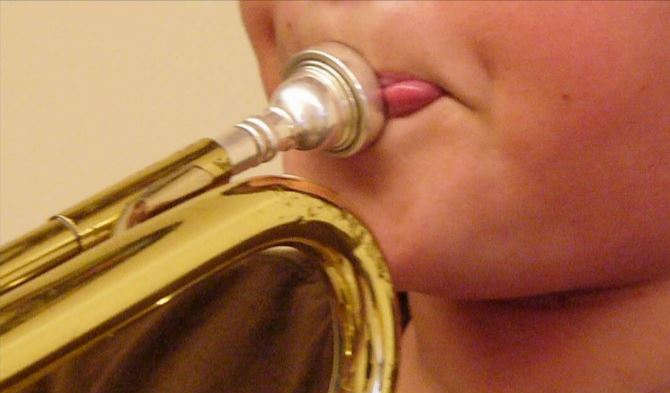
- Pressing the instrument against the lips too tightly. This can hurt your lips and cause a headache. Keep a tight but relaxed embouchure. Having dental braces is an advantage here because braces prevent you from putting too much force on your mouth.
- Puffing out the cheeks. This is tempting at first because it helps you force air through more quickly. But it can tire you out more quickly and make your mouth soar. The more you train your muscles, the better you’ll be able to control the force of your airstream without puffing your cheeks.
- Keeping the jaw muscles too tight. Straining any of your facial muscles for too long will result in pain somewhere. Find a relaxed state where you can produce a steady sound so you don’t tire your muscles out too early.
- Bunching the chin. This often happens when the lips are squeezing together and can cause issues with tone.

Conclusion
Developing a correct trumpet embouchure takes practice. Don’t be discouraged! Even professional trumpeters often struggled with getting this right when they first picked up their instrument.
The best thing you can do to grow is have fun and practice consistently. If you struggle with this process, listen to different music that features trumpets and find a style that keeps you motivated. This can help you stick it out and persevere through this and any other obstacles you face with trumpet.
Thank you this will help me so much
No problem, Jack.
Will being older make a difference? I am 80 and trying to get back into the trumpet after many years of not playing. Otherwise in good shape, but it seems difficult to get the e, f and gs consistently. Lips tire fast. Will more work help?